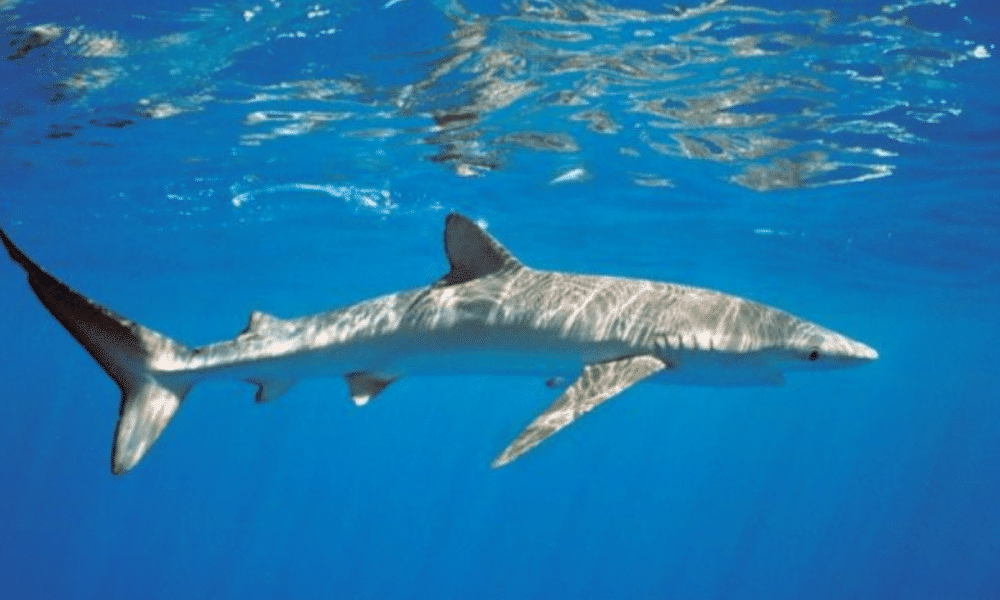A 55-year-old Canadian tourist, identified as Nathalie Ross, lost both hands after a shark attack while attempting to take a selfie in the Turks and Caicos Islands in the Caribbean. What was meant to be a moment of leisure during her vacation turned tragic when she approached the 1.8-meter shark in shallow waters on February 7, 2025. The incident, which occurred near Providenciales, the main island of the archipelago, resulted in severe injuries that required the amputation of both her hands. Ross was immediately rushed to Cheshire Hall Medical Centre for emergency treatment before being transferred back to Canada for further care.
The shark, believed to be a bull shark, known for its aggressive nature, attacked as Ross extended her arms to capture the photo. Her husband reportedly tried to fend off the animal, but the damage had already been done. The beach was temporarily closed after the attack and reopened on February 9. The event has sparked widespread discussion about the dangers of human interaction with wildlife, particularly in the pursuit of capturing extraordinary moments on camera.
Shark attacks in the Caribbean are rare but not unheard of. This incident serves as a stark reminder of the risks associated with such interactions, highlighting the need for tourists to exercise caution and respect marine life. The psychological impact on victims of shark attacks often goes beyond physical injuries, underscoring the importance of comprehensive support during recovery.
Turks and Caicos Islands: a marine biodiversity hotspot
The Turks and Caicos Islands, located in the Atlantic Ocean, are renowned for their crystal-clear waters and rich marine biodiversity, attracting thousands of tourists each year. The region is home to various shark species, including bull sharks, lemon sharks, and reef sharks. Bull sharks, in particular, are known for their adaptability and aggressive behavior, especially when provoked or threatened.
The archipelago has a history of harmonious coexistence with marine life, but incidents like the one involving Nathalie Ross are alarming. The last significant shark attack in the region occurred in 2019 when an American tourist was bitten while diving. In response to the recent attack, authorities have reinforced safety guidelines for tourists, emphasizing the importance of maintaining a safe distance from marine animals.
Growing risks of selfies in dangerous settings
The quest for the perfect selfie has led many tourists to dangerous situations. Statistics reveal that between 2011 and 2017, 259 people died while taking selfies globally, a number five times higher than shark attack fatalities during the same period. These incidents include falls from cliffs, building ledges, and animal attacks, similar to the tragedy in the Turks and Caicos Islands.
To mitigate these risks, experts recommend:
- Establishing safe zones for photography in tourist areas
- Installing warning signs about local hazards
- Conducting educational campaigns on travel safety
- Enforcing temporary restrictions in high-risk areas during peak seasons
A Canadian tourist lost both her hands when she tried to take a picture with a 6-foot shark while swimming in Turks and Caicos and it bit her. pic.twitter.com/TkGPD7i0NA
— Ernesto Abreu (@ernestolabreu) February 18, 2025
Anatomy of the Caribbean shark attack
Nathalie Ross was in shallow waters, typically considered safe for swimmers, when she spotted the shark and decided to take a photo. As she extended her arms to capture the selfie, the shark attacked, biting both her hands. Witnesses reported that her husband attempted to pull her away, but the injuries were severe, leading to amputations below the wrist on one hand and mid-forearm on the other. The shark’s size and behavior suggested it might have been a bull shark, a species frequently sighted in the region.
Immediate medical intervention saved Ross’s life, but the permanent loss of her hands highlights the potential consequences of close encounters with wildlife. The incident has intensified discussions on the importance of respecting nature and adhering to safety protocols.
Shark behavior and risk factors
Sharks, as apex predators, rarely target humans as prey. However, certain factors can trigger attacks, including sudden movements, shiny objects, and proximity. Studies indicate that:
- Bull sharks account for approximately 20% of recorded shark attacks worldwide
- Murky waters increase attack risks due to limited visibility
- Feeding sharks can alter their natural behavior, making them more aggressive
- Bright accessories can attract sharks as they resemble fish scales
Understanding these factors is crucial for preventing shark attacks and ensuring safe human interactions with marine life.
Shark attack statistics
Recent data shows a decline in shark attacks in 2024, with only 47 unprovoked incidents recorded worldwide, the lowest in 30 years. Contributing factors include:
- Decreasing shark populations due to overfishing
- Enhanced public education on marine safety
- Improved monitoring in tourist areas
Despite the decline, the Caribbean attack underscores the need for vigilance. Statistics reveal that:
- 60% of shark attacks occur in shallow waters near shore
- Most attacks happen between 2 PM and 4 PM
- 70% of shark attack victims are surfers and swimmers
Physical and psychological impact on victims
The physical trauma from shark attacks is often accompanied by profound psychological effects. Survivors frequently experience:
- Post-traumatic stress disorder (PTSD)
- Persistent fear of water-related activities
- Depression due to physical limitations
- Prolonged rehabilitation and psychological support needs
Nathalie Ross’s recovery process includes extensive rehabilitation, prosthetic adaptation, and psychological counseling to help her cope with the drastic changes in her daily life.
Safety measures for tourists in shark-prone areas
To prevent similar incidents, tourists are advised to follow strict safety measures, such as:
- Avoid swimming at dawn or dusk when sharks are most active
- Maintain a minimum distance of 30 meters from any shark sighting
- Refrain from swimming with open wounds, as blood attracts sharks
- Wear neutral-colored swimwear to avoid drawing attention
Responsible tourism and marine life protection
Responsible tourism involves respecting natural habitats and adopting safe practices. Tour operators should:
- Provide clear safety instructions for aquatic activities
- Avoid practices like feeding sharks
- Promote environmental education among visitors
Safe interactions with marine life not only protect tourists but also preserve ecosystems for future generations.
Shark facts and curiosities
- Sharks have existed for over 400 million years
- Some species, like the whale shark, can grow up to 12 meters long
- Sharks can detect a single drop of blood diluted in 100 liters of water
- The 1975 movie “Jaws” amplified public fear despite the low incidence of real shark attacks
- Sharks have multiple rows of teeth that are continuously replaced throughout their lives

A 55-year-old Canadian tourist, identified as Nathalie Ross, lost both hands after a shark attack while attempting to take a selfie in the Turks and Caicos Islands in the Caribbean. What was meant to be a moment of leisure during her vacation turned tragic when she approached the 1.8-meter shark in shallow waters on February 7, 2025. The incident, which occurred near Providenciales, the main island of the archipelago, resulted in severe injuries that required the amputation of both her hands. Ross was immediately rushed to Cheshire Hall Medical Centre for emergency treatment before being transferred back to Canada for further care.
The shark, believed to be a bull shark, known for its aggressive nature, attacked as Ross extended her arms to capture the photo. Her husband reportedly tried to fend off the animal, but the damage had already been done. The beach was temporarily closed after the attack and reopened on February 9. The event has sparked widespread discussion about the dangers of human interaction with wildlife, particularly in the pursuit of capturing extraordinary moments on camera.
Shark attacks in the Caribbean are rare but not unheard of. This incident serves as a stark reminder of the risks associated with such interactions, highlighting the need for tourists to exercise caution and respect marine life. The psychological impact on victims of shark attacks often goes beyond physical injuries, underscoring the importance of comprehensive support during recovery.
Turks and Caicos Islands: a marine biodiversity hotspot
The Turks and Caicos Islands, located in the Atlantic Ocean, are renowned for their crystal-clear waters and rich marine biodiversity, attracting thousands of tourists each year. The region is home to various shark species, including bull sharks, lemon sharks, and reef sharks. Bull sharks, in particular, are known for their adaptability and aggressive behavior, especially when provoked or threatened.
The archipelago has a history of harmonious coexistence with marine life, but incidents like the one involving Nathalie Ross are alarming. The last significant shark attack in the region occurred in 2019 when an American tourist was bitten while diving. In response to the recent attack, authorities have reinforced safety guidelines for tourists, emphasizing the importance of maintaining a safe distance from marine animals.
Growing risks of selfies in dangerous settings
The quest for the perfect selfie has led many tourists to dangerous situations. Statistics reveal that between 2011 and 2017, 259 people died while taking selfies globally, a number five times higher than shark attack fatalities during the same period. These incidents include falls from cliffs, building ledges, and animal attacks, similar to the tragedy in the Turks and Caicos Islands.
To mitigate these risks, experts recommend:
- Establishing safe zones for photography in tourist areas
- Installing warning signs about local hazards
- Conducting educational campaigns on travel safety
- Enforcing temporary restrictions in high-risk areas during peak seasons
A Canadian tourist lost both her hands when she tried to take a picture with a 6-foot shark while swimming in Turks and Caicos and it bit her. pic.twitter.com/TkGPD7i0NA
— Ernesto Abreu (@ernestolabreu) February 18, 2025
Anatomy of the Caribbean shark attack
Nathalie Ross was in shallow waters, typically considered safe for swimmers, when she spotted the shark and decided to take a photo. As she extended her arms to capture the selfie, the shark attacked, biting both her hands. Witnesses reported that her husband attempted to pull her away, but the injuries were severe, leading to amputations below the wrist on one hand and mid-forearm on the other. The shark’s size and behavior suggested it might have been a bull shark, a species frequently sighted in the region.
Immediate medical intervention saved Ross’s life, but the permanent loss of her hands highlights the potential consequences of close encounters with wildlife. The incident has intensified discussions on the importance of respecting nature and adhering to safety protocols.
Shark behavior and risk factors
Sharks, as apex predators, rarely target humans as prey. However, certain factors can trigger attacks, including sudden movements, shiny objects, and proximity. Studies indicate that:
- Bull sharks account for approximately 20% of recorded shark attacks worldwide
- Murky waters increase attack risks due to limited visibility
- Feeding sharks can alter their natural behavior, making them more aggressive
- Bright accessories can attract sharks as they resemble fish scales
Understanding these factors is crucial for preventing shark attacks and ensuring safe human interactions with marine life.
Shark attack statistics
Recent data shows a decline in shark attacks in 2024, with only 47 unprovoked incidents recorded worldwide, the lowest in 30 years. Contributing factors include:
- Decreasing shark populations due to overfishing
- Enhanced public education on marine safety
- Improved monitoring in tourist areas
Despite the decline, the Caribbean attack underscores the need for vigilance. Statistics reveal that:
- 60% of shark attacks occur in shallow waters near shore
- Most attacks happen between 2 PM and 4 PM
- 70% of shark attack victims are surfers and swimmers
Physical and psychological impact on victims
The physical trauma from shark attacks is often accompanied by profound psychological effects. Survivors frequently experience:
- Post-traumatic stress disorder (PTSD)
- Persistent fear of water-related activities
- Depression due to physical limitations
- Prolonged rehabilitation and psychological support needs
Nathalie Ross’s recovery process includes extensive rehabilitation, prosthetic adaptation, and psychological counseling to help her cope with the drastic changes in her daily life.
Safety measures for tourists in shark-prone areas
To prevent similar incidents, tourists are advised to follow strict safety measures, such as:
- Avoid swimming at dawn or dusk when sharks are most active
- Maintain a minimum distance of 30 meters from any shark sighting
- Refrain from swimming with open wounds, as blood attracts sharks
- Wear neutral-colored swimwear to avoid drawing attention
Responsible tourism and marine life protection
Responsible tourism involves respecting natural habitats and adopting safe practices. Tour operators should:
- Provide clear safety instructions for aquatic activities
- Avoid practices like feeding sharks
- Promote environmental education among visitors
Safe interactions with marine life not only protect tourists but also preserve ecosystems for future generations.
Shark facts and curiosities
- Sharks have existed for over 400 million years
- Some species, like the whale shark, can grow up to 12 meters long
- Sharks can detect a single drop of blood diluted in 100 liters of water
- The 1975 movie “Jaws” amplified public fear despite the low incidence of real shark attacks
- Sharks have multiple rows of teeth that are continuously replaced throughout their lives







